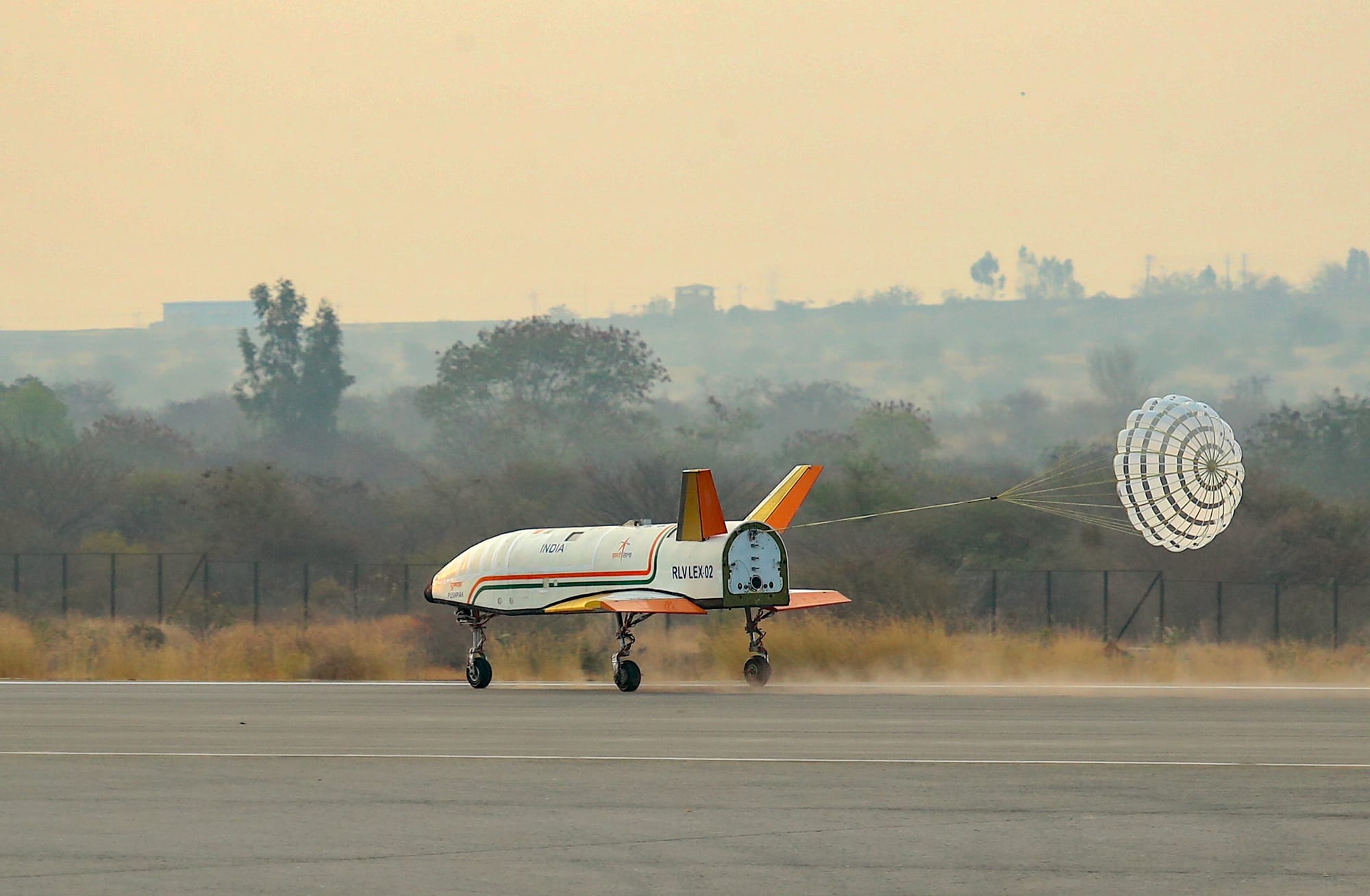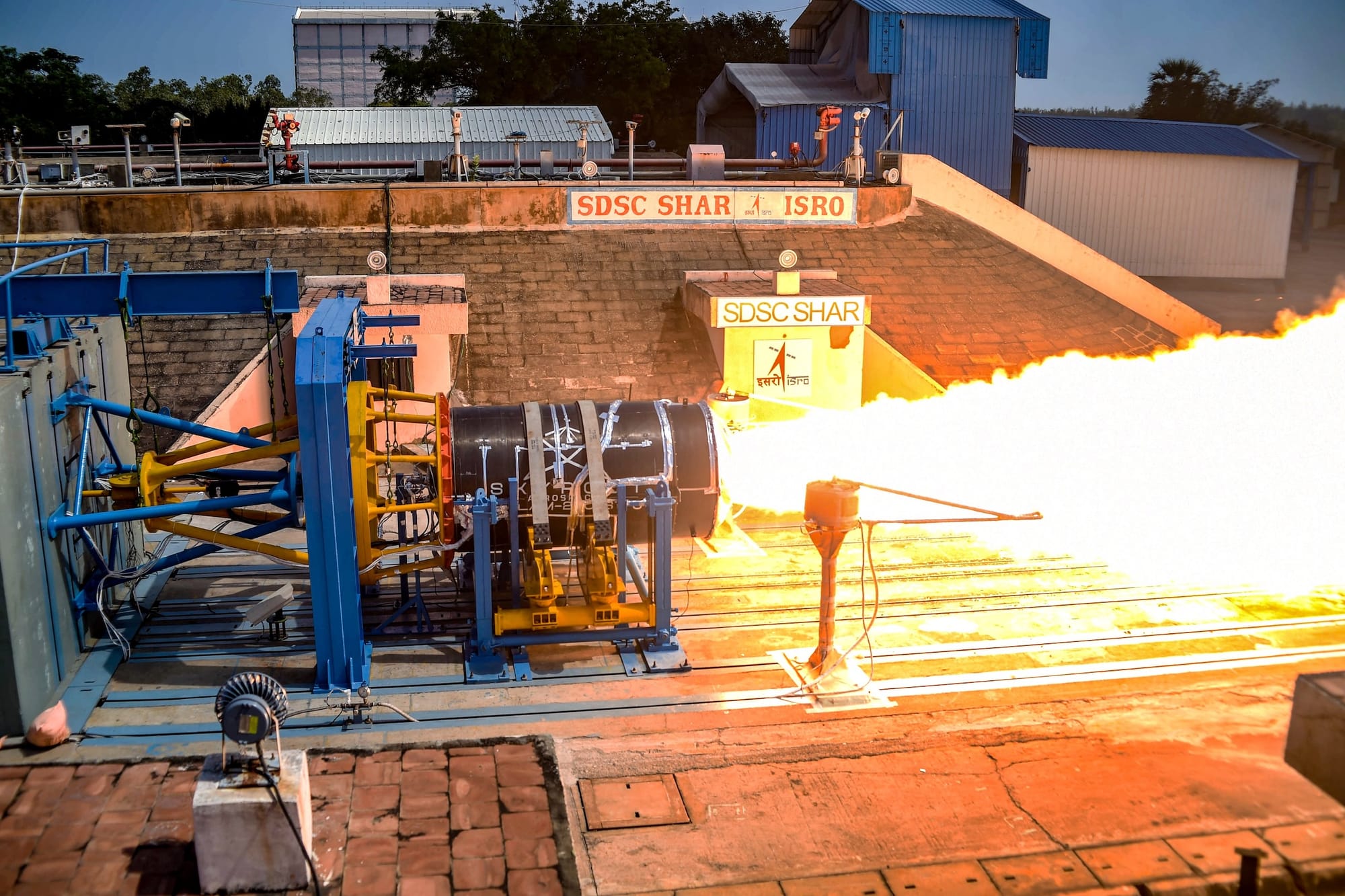Indian Space Progress #14: On ISRO landing a spaceplane, and perspectives on Indian space
An update about the last Indian Space Progress edition before we begin this one: My review of India’s Gaganyaan mission to send astronauts to space has been republished on Jeff Foust’s revered community blog The Space Review! ^_^
How ISRO is building a reusable spaceplane

Almost a year after ISRO successfully landed an uncrewed, autonomous spaceplane prototype on a runway at Chitradurga, India, the space agency conducted another such landing test on March 22. The winged vehicle is internally called the Reusable Launch Vehicle Technology Demonstrator (RLV-TD), and was recently officially named Pushpak by the Indian Prime Minister—after the flying chariot in Hindu mythology.
Like in the previous test, Pushpak was dropped from a height of 4.5 kilometers by an Indian Air Force helicopter such that its descent simulates an approach from space. But unlike the last time, as Chethan Kumar reports, the plane was dropped away from the runway—which lay four kilometers downrange. Pushpak then course-corrected on its own and maneuvered itself to the runway, where it deployed a parachute to kill much of its velocity of 350 kilometers per hour and steadily came to a halt. ISRO says engineers strengthened the airframe structure and landing gear for this test so it could tolerate higher landing loads.
Aiming for orbit
ISRO is planning a third landing test of the spaceplane later this year with more stringent drop conditions. If it goes well too, in its next flight Pushpak will attempt an orbital re-entry after being launched on a modified GSLV rocket. In 2016, ISRO had launched a heat-shield-enabled Pushpak to an altitude of 65 kilometers and hypersonic speeds. It successfully steered itself 450 kilometers downrange to a sea splashdown in a targeted zone.
When operational, a 60% larger Pushpak will comprise the second stage or equivalent of an Indian reusable launch vehicle (RLV). In fact, it’s to this aspirational end that the winged body and all flight systems from the 2023 test were reused in the flight last week, after being re-certified.
ISRO envisions the orbital Pushpak to spend up to a month in space, autonomously operate onboard payloads and experiments, and then de-orbit itself for atmospheric reentry leading to a runway landing. At some point, ISRO has also intended to test air-breathing propulsion on a future flight to assess its viability as part of Pushpak’s ongoing design ideation.
What India’s spaceplane isn’t: Media outlets have frequently compared the RLV-TD/Pushpak to NASA’s retired Space Shuttle. But ISRO is neither designing Pushpak to carry humans to space nor is it intended to be a heavy-lift launch vehicle. As a highly autonomous platform, Pushpak will be much more akin to the flying Boeing X-37B and Sierra Space’s upcoming Dream Chaser.
Note that the RLV is also different from ISRO’s other upcoming partially reusable rocket called the Next Generation Launch Vehicle (NGLV), which is much bigger. It recently got a formal project team but ISRO expects the NGLV to take about a decade to launch. Both the NGLV and RLV are exciting projects that could boost India’s rocket fleet but are a low priority as ISRO remains focused on its Gaganyaan program to indigenously send humans to space this decade.
Lunar and space science updates

- The POLIX polarimeter on India’s recently launched second space telescope called XPoSat has begun scientific observations. Over the next few years, POLIX will study the polarization of X-rays emitted by various cosmic objects, which uniquely informs scientists about the physical nature of those objects—such as the strength and distribution of their magnetic fields. NASA launched the IXPE space telescope on a similar mission in December 2021. IXPE and XPoSat are the world’s only telescopes dedicated for said purpose. When scientists are able to utilize and combine unique data from both these telescopes, we’ll get new insights into many bright X-ray sources, including pulsars, binary stars, and galactic cores. XPoSat’s other instrument XSPECT began observations in January.
- In an interview with Chethan Kumar for the Times of India, ISRO Chief S. Somanath said that work is progressing slowly on new throttle-able engines needed for the 6,000-kilogram ISRO lander which will deliver JAXA’s LUPEX rover to the Moon’s south pole by end of decade to study water ice and other volatiles. Somanath added that ISRO is preparing a funding proposal for the Chandrayaan 4 sample return mission now that preliminary studies are done.
- At the 55th Lunar and Planetary Science Conference (LPSC) this month, several Indian lunar researchers presented their recent work. I found the following of note for this blog & newsletter:
- Initial elemental composition measurements from the Chandrayaan 3 rover
- ISRO’s Chandrayaan 2 orbiter data helping NASA downselect areas within the Artemis landing zones using infrared and radar measurements, the former to help find spots with water ice and the latter to help reduce false positives from terrain having rough textures.
- On February 14, the UK Space Agency announced that it will fund Royal Holloway, University of London (RHUL) with £306,000 to develop software for ISRO’s Chandrayaan 2 orbiter to help its multi-band radar better detect underground water ice on the Moon’s south pole. UKSA, RHUL, and ISRO hope to use the same advancement for mapping Venus in high resolution using the radar on India’s upcoming Shukrayaan orbiter. Note: Shukrayaan is not yet a commissioned mission from the Indian Government, and might not launch before end of decade.
Many thanks to the Takshashila Institution, KaleidEO, Gurbir Singh and Arun Raghavan for sponsoring this month’s Indian Space Progress report. If you love my work too, join them!
More Indian space updates

- The new INSAT-3DS meteorological satellite, which ISRO launched on February 17, has begun imaging Earth.
- US-based Loft Orbital and India-based SkyServe have partnered to utilize the former’s YAM-6 satellite—launched on a Falcon 9 Transporter mission on March 4—with SkyServe’s edge computing platform so as to enable analyzing Earth observation images in near real-time and power more analytics from it.
- With help from ISRO, Hyderabad-based Skyroot successfully test fired the Kalam-250 second stage motor part of its upcoming orbital rocket Vikram-I. The company recently raised $27.5 million, hoping to launch Vikram-I by end of year. 2025 remains more likely though. Skyroot previously launched suborbital test mission Prarambh in November 2022, becoming India’s first such privately developed rocket. Other recent milestones for Skyroot in the lead up to launch of Vikram-I include flight qualifying its Raman-I engine, which will provide roll attitude control, hot firing the Raman-II engine powering Vikram-I’s fourth stage, and the Vikram-I first stage passing pressure testing.
Some key perspectives on Indian space
Casey Dreier of The Planetary Society has an excellent interview of Gurbir Singh (a sponsor of Indian Space Progress) on the unique origin, paths, and motivations of India’s space program.
Casey Dreier: You write that, unlike the space programs being established at the time in the U.S. and Soviet Union, India’s program from the outset was wholly non-military and built to meet the social needs of its huge population. It was really almost inwardly directed as a modernizing force rather than a demonstration of technological competition or global hegemony.
Gurbir Singh: Having lived under suppression, under the control of another nation, was seen as a national humiliation. India did not want to return to that. There was a desire for self-sufficiency rather than some sort of hegemony or sense of superiority over other countries. India is probably the only country with a space program which had entirely non-military foundations, although since then, it has grown to include military aspects.
This is worth highlighting also because something as basic as the origin of the Indian space program is what the New York Times misrepresents, among other things fundamental to how Indian space functions.
Jayant Murthy, a renowned astrophysicist who just had an asteroid named after him by the International Astronomical Union for his contributions, encapsulated his critique of the current direction of Indian space in a new interview for The Hindu:
Preeti Zachariah: What do you think of India’s current space program?
Jayant Murthy: I think the space program has done very well. There are many places where we can do better. For instance, the Chinese space program used to be well behind us, but now, in 20 years, it is far ahead.
But the current revamp is good for ISRO. It was always supposed to be the Indian Space Research Organization, but they ended up getting into routine things. How is your 100th PSLV ( Polar Satellite Launch Vehicle) going to be different from your 99th?
It is good that they are getting into private industry, but the main problem, I see, with the revamp is that the government has still not realized that space is still driven by government money. They are expecting private investors to come in, and that is not realistic. They have projected a lot of money being put into the system, but I think it may be difficult.
When many Indian startups have failed to explicitly talk about customers even during the highs of their marketing & communications tied to engineering milestones, it’s hard to disagree with Jayant Murthy’s take.
For more such perspectives on Indian space, I also recommend checking out Memory Monologues and Perspectives from Spaceport SARABHAI, India’s first space think tank.
